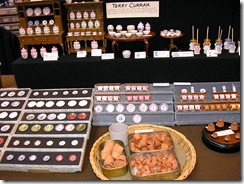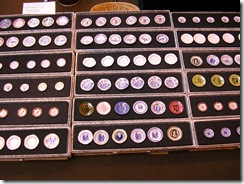So there you are, merrily whizzing along, being optimistic after a grotty bit. Just as you believe you’re up and running again, suddenly, whump! You didn’t notice life sitting there with its foot in the aisle waiting to trip you up.
Fifteen years ago I had a gallon jar of slip, then I had a kiln. In short order I also had some shows booked and there was my happy threesome, kiln, slip, shows. After one show I turned this into a foursome by adding my own plaster moulds to the triumvirate. Shortly thereafter it turned into a quincumvirate by adding magazine writing where I happily stayed for fifteen years. As you may have guessed, I was planning by web extrusion to convert this into what I can only call, following precedent, a sexumvirate. However, life with its foot in the aisle had other ideas.
For some years I had major problems with obtaining plaster of Paris to make moulds. Not all plaster is created the same, considering it’s gypsum dug off a rock face, you’d have thought so but it ain’t. I started by getting it from the chemist’s shop; a major high street chain stocked it for years and I was very used to that brand. Then they discontinued it. Subsequently I discovered some in independent chemists, which wasn’t the same, for ages I made really lumpy moulds until I adapted my techniques. Then they stopped doing it too and in the course of numerous phone calls to track some down I found out more about the chain of supply between plaster manufacturers and British Gypsum than I ever wanted to know. It was still readily available for the building industry and for some months I seriously contemplated having a 500Kg pack delivered, working out that if I made moulds at an accelerated rate we would get the living room back in about 2018. Finally when I had tried every ‘hobby’ plaster in the known universe, most of it awful, and was down to my last hoarded teaspoon of the good stuff, I found via the blessed internet, a proper plaster suppliers in Birmingham, hurrah, had a lovely, intelligent, highly specialised, plaster conversation on the phone followed by delivery of a huge (but not lounge sized) bag of plaster and all was well, I was on my way again.
Whump! Supplies of the slip dried up. Here comes a quick paragraph of history, which you can skip if you like, there are absolutely no tests at the end of this (though there are some plates.)
In the beginning there were a couple of American families who leapt upon the invention of the kiln for domestic use to create moulds, teaching and so spreading the making of porcelain dolls. Hurrah! In the process they also created china paints, techniques and a pourable slip by importing clay dug up in Britain and adding a variety of elements not native to these shores and water. Birds sang, clouds passed, dolls got made, time passed, the instigators of all this joy retired.
So, just as it does if you leave it on the carpet, the slip dried up. Small pockets of it were to be found in old shops, kiln manufactories and similar places across the whole of the northern hemisphere. I could see what was going to happen. History was going to repeat itself in the same way that the supply of dolls dwindled and vanished after the first World War. A porcelain doll is a surprisingly complex product requiring supplies from a diverse range of sources. In art generally, if commodities become unavailable, people give up or take their talents elsewhere. Doll makers, it should be noted, are more tenacious than other breeds of human, if it gets really bad we’ll all be out in the back garden with a shovel looking for clay, though a manufactured slip would give more consistent results. Happily, at a Bears and Dolls show, I met Maxine Winkle, a force of nature working nominally for Potclays but really for the good of all and persuaded her to agree to some slip experiments. As I would not expect anyone to spend time and budget investigating an unsaleable commodity, I then rang every doll maker in the country and asked them to contact Maxine and tell her what they wanted in a pourable doll slip. This occurred when doll makers abroad were still confident of supplies. The desert has now become subject to intercontinental drift and Potclays having been diverted to glaze experiments, by the urgent need of tile manufacturers or some such, the slip has slipped to a holding position. I will contact Maxine again very soon with more evidence, after which, if you are a doll maker, suddenly slipless, in what blog reader Phillipa refers to as ‘furrin parts’, I’ll be asking for the weight of your opinion too.
The slip-up foot in the aisle may be on the way to being socked, watch this space. So now, counting on the fingers, web space, slip (possibly), plaster, show, magazines. Great, that’s the six then. Oh no, hang on, on the one hand that’s just five, on the other there’s something underhand afoot.
What’s missing? The kiln. You’ll recall in a previous blog how I had a throbbing hot orange rod just beside the melting electrics in my kiln sitter? I also have a rusting lid, little black specs on the dolls and a kiln that wouldn’t turn on. I rang the manufacturer, the very lovely Cromartie Kilns, who have been making them for sixty years. They’ve stopped. Next nearest kiln from elsewhere costs a thousand pounds, which seems like a lot. Because it is. And I don’t even know if there will be slip. Do you know, at this point I felt like Frodo on a rock in the lava confidently expecting the end of all things. I so did. When the going gets tough what the tough do is go and have a moan to anyone who will listen at Miniatura. I did tell you about the moaning on the first Miniatura blog. It’s an artist thing, engendered by the difficulty of doing lifetime craft skills and getting up at dawn to do a show.
I moaned to Terry Curran who, amazingly, had a spare kiln. Yup, the eagle coming to pick me off the hot rock was none other than the one and only Terry Curran best manufacturer of miniature domestic art pottery in the miniverse. (He’s so good he’s even in a serious reference work about big potters.) He had a kiln, same as mine but the previous model, dragged out of a cupboard rusty, dusty and needing a very good going over by a kiln engineer. So we went up to Sheffield today and got it. So far I’ve washed it and hugged it. It’s going to be a while before I can afford an expensive visit from the kiln doctor, and it depends what the same says of the health of the said object but the remote possibility of skipping the foot in the aisle is hovering eaglishly, on the edge of sight. After which, new dolls! (And that means bargain prices on old ones coming to a site near you- well, here really- quite soon, kiln engineers permitting.)
Fantastic ceramics from Terry Curran, miniature virtuoso, obsessive potter and saviour with a spare kiln in a cupboard. (Like you do.)



3 Responses to Foot in the aisle.